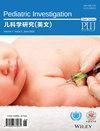The clinical characteristics and risk factors for necrotizing soft tissue infection in children
IF 2
4区 医学
Q2 PEDIATRICS
引用次数: 0
Abstract
Necrotizing soft tissue infection (NSTI) is a serious infectious disease. However, the early clinical manifestations and indicators of NSTI in children are still unclear.The purpose of this study was to analyze the clinical characteristics and risk factors of NSTI in pediatric patients.A total of 127 children with skin and soft tissue infection (SSTI) were treated at our hospital and divided into two groups: the NSTI group and the non‐NSTI group, based on their discharge diagnosis from January 2011 to December 2022. Then, we collected and analyzed the clinical characteristics and risk factors of all patients, including sex and age, disease inducement, admission temperature, local skin manifestations, infection site, the presence of sepsis, bacterial culture, and laboratory indicators.In our study, there was a statistical difference in the age distribution and disease inducement between NSTI and non‐NSTI groups. The occurrence of local skin manifestations (blisters/bullae and ecchymosis) and the presence of sepsis significantly increased in the NSTI group compared to the non‐NSTI group. Additionally, only the platelet count on laboratory tests was statistically different between the NSTI and non‐NSTI groups. Finally, the logistic regression analysis suggested that local skin manifestations such as blisters/bullae, and ecchymosis, as well as the presence of sepsis, were identified as risk factors for NSTI.Children with SSTI and skin manifestations such as blisters/bullae, ecchymosis, and the presence of sepsis are at a higher risk of developing NSTI. These symptoms serve as useful indicators for early detection of NSTI.儿童坏死性软组织感染的临床特征和风险因素
坏死性软组织感染(NSTI)是一种严重的传染病。然而,儿童NSTI的早期临床表现和指标尚不清楚。本研究旨在分析小儿NSTI的临床特点及危险因素。选取我院2011年1月至2022年12月收治的127例皮肤软组织感染(SSTI)患儿,根据出院诊断分为皮肤软组织感染组和非皮肤软组织感染组。然后收集并分析所有患者的临床特征及危险因素,包括性别、年龄、疾病诱因、入院温度、局部皮肤表现、感染部位、是否存在败血症、细菌培养、实验室指标等。在我们的研究中,NSTI组和非NSTI组在年龄分布和疾病诱因方面存在统计学差异。与非NSTI组相比,NSTI组的局部皮肤表现(水泡/大疱和瘀斑)和败血症的发生率显著增加。此外,只有实验室检测的血小板计数在NSTI组和非NSTI组之间有统计学差异。最后,logistic回归分析表明,局部皮肤表现如水泡/大疱、瘀斑以及脓毒症的存在是NSTI的危险因素。患有SSTI和皮肤表现(如水泡/大疱、瘀斑和败血症)的儿童发生NSTI的风险更高。这些症状是早期发现NSTI的有用指标。
本文章由计算机程序翻译,如有差异,请以英文原文为准。
求助全文
约1分钟内获得全文
求助全文
来源期刊

Pediatric Investigation
Medicine-Pediatrics, Perinatology and Child Health
CiteScore
3.30
自引率
0.00%
发文量
176
审稿时长
12 weeks
 求助内容:
求助内容: 应助结果提醒方式:
应助结果提醒方式:


